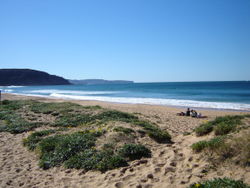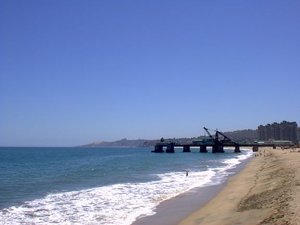Pacific Ocean
2007 Schools Wikipedia Selection. Related subjects: General Geography
| Earth's five oceans |
|---|
|
The Pacific Ocean (from the Latin name Mare Pacificum, "peaceful sea", bestowed upon it by the Portuguese explorer Ferdinand Magellan) is the world's largest body of water.
Overview
The ocean encompasses a third of the Earth's surface, having an area of 179.7 million square kilometres (69.4 million sq mi and 161 million cubic mi) —significantly larger than Earth's entire landmass, with room for another Africa to spare. Extending approximately 15,500 kilometres (9,600 mi) from the Bering Sea in the Arctic to the icy margins of Antarctica's Ross Sea in the south (although the Antarctic regions of the Pacific are sometimes described as part of the circumpolar Southern Ocean), the Pacific reaches its greatest east-west width at about 5°N latitude, where it stretches approximately 19,800 kilometres (12,300 mi) from Indonesia to the coast of Colombia and Peru. The western limit of the ocean is often placed at the Strait of Malacca. The lowest point on earth—the Mariana Trench—lies 10,911 metres (35,797 ft) below sea level. Its average depth is 4,300 metres (14,000 ft).
The Pacific contains about 25,000 islands (more than the total number in the rest of the world's oceans combined), the majority of which are found south of the equator.
The Pacific Ocean is currently shrinking from plate tectonics, while the Atlantic Ocean is increasing in size.
Along the Pacific Ocean's irregular western margins lie many seas, the largest of which are the Celebes Sea, Coral Sea, East China Sea, Philippine Sea, Sea of Japan, South China Sea, Sulu Sea, Tasman Sea, and Yellow Sea. The Strait of Malacca joins the Pacific and the Indian Oceans on the west, and the Strait of Magellan links the Pacific with the Atlantic Ocean on the east. To the north, the Bering Strait connects the Pacific with the Arctic Ocean.
As the Pacific straddles the ± 180° meridian, the West Pacific (or western Pacific, near Asia) is actually in the Eastern Hemisphere, while the East Pacific (or eastern Pacific, near the Americas) is actually in the Western Hemisphere.
For most of Magellan's voyage from the Strait of Magellan to the Philippines, the explorer indeed found the ocean peaceful. However, the Pacific is not always peaceful. Many tropical cyclones ( typhoons, the equivalent of Atlantic hurricanes), batter the islands of the Pacific. The lands around the Pacific rim are full of volcanoes and often affected by earthquakes. Tsunamis, caused by underwater earthquakes, have devastated many islands and destroyed entire towns.

Water characteristics
Water temperatures in the Pacific vary from freezing in the poleward areas to about 25-30 ° Celsius (84 ° F) near the equator. Salinity also varies latitudinally. Water near the equator is less salty than that found in the mid-latitudes because of abundant equatorial precipitation throughout the year. Poleward of the temperate latitudes salinity is also low, because little evaporation of seawater takes place in these frigid areas. The Pacific ocean is generally warmer than the Atlantic ocean.
The surface circulation of Pacific waters is generally clockwise in the Northern Hemisphere (the North Pacific Gyre) and counter-clockwise in the Southern Hemisphere. The North Equatorial Current, driven westward along latitude 15°N by the trade winds, turns north near the Philippines to become the warm Japan or Kuroshio Current.
Turning eastward at about 45°N, the Kuroshio forks and some waters move northward as the Aleutian Current, while the rest turn southward to rejoin the North Equatorial Current. The Aleutian Current branches as it approaches North America and forms the base of a counter-clockwise circulation in the Bering Sea. Its southern arm becomes the chilled slow, south-flowing California Current.
The South Equatorial Current, flowing west along the equator, swings southward east of New Guinea, turns east at about 50°S, and joins the main westerly circulation of the Southern Pacific, which includes the Earth-circling Antarctic Circumpolar Current. As it approaches the Chilean coast, the South Equatorial Current divides; one branch flows around Cape Horn and the other turns north to form the Peru or Humboldt Current.
Geology
The Andesite Line is the most significant regional distinction in the Pacific. It separates the deeper, alkaline igneous rock of the Central Pacific Basin from the partially submerged continental areas of acidic igneous rock on its margins. The Andesite Line follows the western edge of the islands off California and passes south of the Aleutian arc, along the eastern edge of the Kamchatka Peninsula, the Kuril Islands, Japan, the Mariana Islands, the Solomon Islands, and New Zealand. The dissimilarity continues northeastward along the western edge of the Albatross Cordillera along South America to Mexico, returning then to the islands off California. Indonesia, the Philippines, Japan, New Guinea, and New Zealand—all eastward extensions of the continental blocks of Australia and Asia—lie outside the Andesite Line.
Within the closed loop of the Andesite Line are most of the deep troughs, submerged volcanic mountains, and oceanic volcanic islands that characterize the Central Pacific Basin. Here basaltic lavas gently flow out of rifts to build huge dome-shaped volcanic mountains whose eroded summits form island arcs, chains, and clusters. Outside the Andesite Line, volcanism is of the explosive type, and the Pacific Ring of Fire is the world's foremost belt explosive volcanism.
Landmasses
The largest landmass entirely within the Pacific Ocean is the island of New Guinea— the second largest island in the world. Almost all of the smaller islands of the Pacific lie between 30°N and 30°S, extending from South-east Asia to Easter Island; the rest of the Pacific Basin is almost entirely submerged.
The great triangle of Polynesia, connecting Hawaii, Easter Island, and New Zealand, encompasses the island arcs and clusters of the Cook Islands, Marquesas, Samoa, Society, Tokelau, Tonga, Tuamotu, Tuvalu & Wallis and Futuna islands.
North of the equator and west of the International Date Line are the numerous small islands of Micronesia, including the Caroline Islands, the Marshall Islands, and the Mariana Islands.
In the southwestern corner of the Pacific lie the islands of Melanesia, dominated by New Guinea. Other important island groups of Melanesia include the Bismarck Archipelago, Fiji, New Caledonia, the Solomon Islands, and Vanuatu.
Islands in the Pacific Ocean are of four basic types: continental islands, high islands, coral reefs, and uplifted coral platforms. Continental islands lie outside the Andesite Line and include New Guinea, the islands of New Zealand, and the Philippines. These islands are structurally associated with nearby continents. High islands are of volcanic origin, and many contain active volcanoes. Among these are Bougainville, Hawaii, & the Solomon Islands.
The third and fourth types of islands are both the result of coralline island building. Coral reefs are low-lying structures that have built up on basaltic lava flows under the ocean's surface. One of the most dramatic is the Great Barrier Reef off northeastern Australia. A second island type formed of coral is the uplifted coral platform, which is usually slightly larger than the low coral islands. Examples include Banaba (formerly Ocean Island) and Makatea in the Tuamotu group of French Polynesia.
History and economy
Important human migrations occurred in the Pacific in prehistoric times, most notably those of the Austronesians (specifically, the Polynesians) from the Asian edge of the ocean to Tahiti and then to Hawaii and New Zealand, and much later, to Easter Island.
The ocean was sighted by Europeans early in the 16th century, first by Vasco Núñez de Balboa ( 1513), who crossed the Isthmus of Panama, and then by Ferdinand Magellan, who sailed the Pacific during his circumnavigation ( 1519- 1522). In 1564, conquistadors crossed the ocean from Mexico led by Miguel López de Legazpi who sailed to the Philippines and Mariana Islands. For the remainder of the 16th century, Spanish influence was paramount, with ships sailing from Spain to the Philippines, New Guinea, and the Solomon Islands; the Manila Galleons linked Manila and Acapulco. In 16th century also the Ragusean galleys of Dubrovnik led by Vice Bune explored southwestern Pacific, and discovered the islands of Bismarck Archipelago, Vanuatu (New Hebrides), etc.
During the 17th century, the Dutch, sailing around southern Africa, dominated discovery and trade; Abel Janszoon Tasman discovered Tasmania and New Zealand in 1642; in that century Ragusean traders prevailed in Melanesia. The 18th century marked a burst of exploration by the Russians in Alaska and the Aleutian Islands, the French in Polynesia, and the British in the three voyages of James Cook (to the South Pacific and Australia, Hawaii, and the North American Pacific Northwest).
Growing imperialism during the 19th century resulted in the occupation of much of Oceania by Great Britain and France, followed by the United States. Significant contributions to oceanographic knowledge were made by the voyages of the HMS Beagle in the 1830s, with Charles Darwin aboard; the HMS Challenger during the 1870s; the USS Tuscarora (1873-76); and the German Gazelle (1874-76). Although the United States conquered the Philippines in 1898, Japan controlled the western Pacific by 1914 and occupied many other islands during World War II. By the end of the war, the U.S. Pacific Fleet was the virtual master of the ocean.
Seventeen independent states are located in the Pacific: Australia, Fiji, Japan, Kiribati, Marshall Islands, Micronesia, Nauru, New Zealand, Palau, Papua New Guinea, the Philippines, Samoa, Solomon Islands, Republic of China (Taiwan), Tonga, Tuvalu, and Vanuatu. Eleven of these nations have achieved full independence since 1960. The Northern Mariana Islands are self-governing with external affairs handled by the United States, and Cook Islands and Niue are in similar relationships with New Zealand. Also within the Pacific is the U.S. state of Hawaii and several island territories and possessions of Australia, Chile, Ecuador, France, Japan, New Zealand, the United Kingdom, and the United States.
The exploitation of the Pacific's mineral wealth is hampered by the ocean's great depths. In shallow waters of the continental shelves off the coasts of Australia and New Zealand, petroleum and natural gas are extracted, and pearls are harvested along the coasts of Australia, Japan, Papua New Guinea, Nicaragua, Panama, and the Philippines, although in sharply declining volume in some cases. The Pacific's greatest asset is its fish. The shoreline waters of the continents and the more temperate islands yield herring, salmon, sardines, snapper, swordfish, and tuna, as well as shellfish.
In 1986, the member nations of the South Pacific Forum declared the area a nuclear-free zone in an effort to halt nuclear testing and prevent the dumping of nuclear waste there.
Major ports and harbours
|
|



